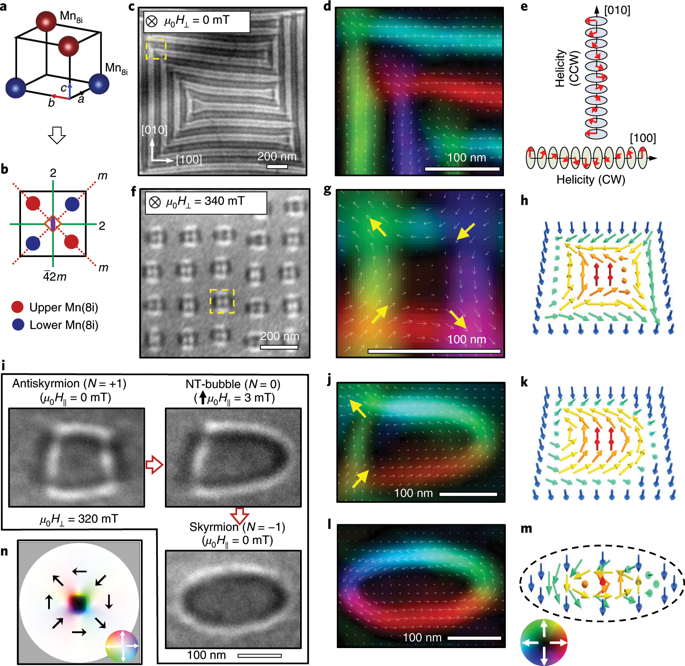Nature Nanotechnology ( IF 38.1 ) Pub Date : 2020-01-20 , DOI: 10.1038/s41565-019-0616-6 Licong Peng 1 , Rina Takagi 1, 2 , Wataru Koshibae 1 , Kiyou Shibata 1, 3 , Kiyomi Nakajima 1 , Taka-Hisa Arima 1, 4 , Naoto Nagaosa 1, 5 , Shinichiro Seki 1, 2 , Xiuzhen Yu 1 , Yoshinori Tokura 1, 5, 6

|
Control of topological spin textures in magnetic systems may enable future spintronic applications. Magnetic field pulses can switch the vortex polarity1 or the winding number of magnetic bubbles2. Thermal energy can reverse the helicity of skyrmions3 and induce the transformation between meron and skyrmion by modifying the in-plane anisotropy4,5. Among the various topological spin textures, skyrmions6,7 and antiskyrmions8,9,10 are nanometric spin-whirling structures carrying integer topological charges (N) of −1 and +1 (refs. 7,11,12), respectively, and can be observed in real space8,13. They exhibit different dynamical properties under current flow14,15,16,17,18, for example, opposite signs for the topological Hall effect. Here we observe, in real space, transformations among antiskyrmions, non-topological (NT) bubbles and skyrmions (with N of +1, 0 and −1, respectively) and their lattices in a non-centrosymmetric Heusler magnet, Mn1.4Pt0.9Pd0.1Sn, with D2d symmetry. Lorentz transmission electron microscopy images under out-of-plane magnetic fields show a square lattice of square-shaped antiskyrmions near the Curie temperature and a triangular lattice of elliptically deformed skyrmions with opposite helicities at lower temperatures. The clockwise and counter-clockwise helicities of the skyrmions originate from Dzyaloshinskii–Moriya interactions with opposite signs along the [100] and [010] directions, respectively. A variation of the in-plane magnetic field induces a topological transformation from antiskyrmions to NT-bubbles and to skyrmions, which is accompanied by a change of the lattice geometry. We also demonstrate control of the helicity of skyrmions by variations of the in-plane magnetic field. These results showcase the control of the topological nature of spin configurations in complex magnetic systems.
中文翻译:

非中心对称磁体中斯格明子和反斯格明子的受控转换
控制磁性系统中的拓扑自旋纹理可以实现未来的自旋电子应用。磁场脉冲可以切换涡流极性1或磁泡的缠绕数量2。热能可以逆转skyrmions 3的螺旋性,并通过修改面内各向异性4,5来诱导meron 和skyrmion 之间的转变。在各种拓扑自旋纹理中,skyrmions 6,7和 antiskyrmions 8,9,10是纳米自旋旋转结构,分别携带-1 和 +1 的整数拓扑电荷(N)(参考文献7,11,12),和可以在真实空间中观察到8,13. 它们在电流14,15,16,17,18下表现出不同的动态特性,例如,拓扑霍尔效应的相反符号。在这里,我们在真实空间中观察到反斯格明子、非拓扑 (NT) 气泡和斯格明子(N分别为 +1、0 和 -1)及其在非中心对称 Heusler 磁体 Mn 1.4 Pt 0.9中的晶格之间的转换Pd 0.1 Sn, D 2d对称。平面外磁场下的洛伦兹透射电子显微镜图像显示了在居里温度附近的方形反skyrmions 的方形晶格和在较低温度下具有相反螺旋度的椭圆形变形skyrmions 的三角形晶格。斯格明子的顺时针和逆时针螺旋分别来自于 Dzyaloshinskii-Moriya 相互作用,它们分别沿 [100] 和 [010] 方向具有相反的符号。平面内磁场的变化引起了从反斯格明子到 NT 气泡再到斯格明子的拓扑转变,这伴随着晶格几何形状的变化。我们还通过平面内磁场的变化证明了对斯格明子螺旋度的控制。











































 京公网安备 11010802027423号
京公网安备 11010802027423号